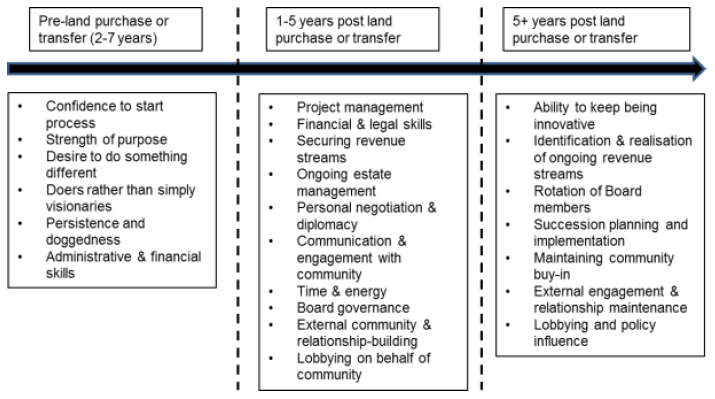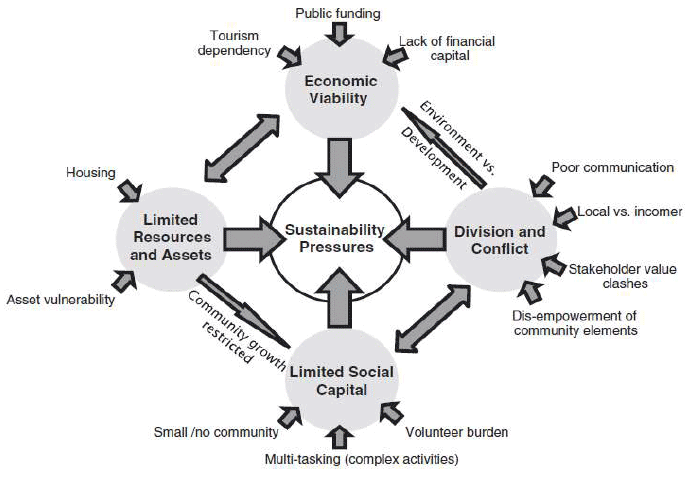Impact Evaluation of the Community Right to Buy
An evaluation of the impact of Community Right To Buy legislation on local communities in the period from 2004 to 2014
2 Background and Context
2.1 This section briefly reviews the impacts of the CRtB legislation, as well as some of the challenges faced by communities in owning and managing land. The section also outlines some challenges to evaluating the CRtB based on evidence from existing studies. More detailed background information, including a chronological summary of land reform and the CRtB, is provided in Appendix C.
Impacts of the Community Right to Buy and wider community land/asset ownership
2.2 As recognised by the Land Reform Review Group (LRRG) in its final report (2014), significant growth in community landownership has occurred over the last 25 years. However, much of this was in fact pre-2003, with the number of community asset acquisitions declining somewhat since 2003 (when the Land Reform (Scotland) Act was passed) (LRRG, 2014). More specifically, despite relevant support measures being put in place, uptake of the 2003 CRtB provisions has been relatively limited (see section 1 for an outline of the number of communities involved at each stage in the process). Notably however, there may be indirect effects of the legislation whereby, for example, the existence of the Act indirectly stimulates, facilitates and underpins buyouts which happen through negotiation rather than any direct utilisation of the Act's prescriptions (Slee et al., 2008; Macleod et al., 2010; Mc Morran et al., 2014).
2.3 Despite widespread anecdotal evidence, systematic assessments of the social, economic or environmental impacts of land and asset ownership by communities and land reform more generally are somewhat limited in Scotland (Skerratt, 2011; Satsangi, 2009; Slee et al, 2008; SQW, 2007), given their importance politically and as potential models of sustainable rural development. Many community land and asset acquisitions have also occurred outwith the CRtB legislative framework (including some post 2003 acquisitions) and attribution of any impact directly to the legislation is difficult if not impossible in certain cases. The CRtB legislation sits within a complex policy and funding framework and other elements of this may have influenced community buyouts to a greater extent than the Act itself.
2.4 Nevertheless, the available evidence does suggest that a variety of impacts can occur through community land and asset ownership (whether it occurs directly through the CRtB or not). Slee et al., (2008, Chp 7) summarise the key benefits associated with community land and asset ownership (evident from a number of studies) as:
- Greater security than a tenancy or an informal arrangement for usage, allowing users to plan better for the future.
- Greater freedom to use an asset for more diverse purposes, opening-up opportunities for infrastructural improvements and new production or consumption activities.
- Access to greater funding, through financial gearing/leverage from a collateral base, thereby enabling more ambitious development.
- Social networking that was inaccessible to private or public landlords but which may deliver efficiencies in local service delivery and business development.
- More of the surplus (profit) from wealth-creating activities based on the asset to be retained within a community, raising local incomes and employment both directly and indirectly through multiplier effects.
- Promoting community cohesion and pride through building confidence and a sense of self-worth through control of an asset, particularly if it has iconic, symbolic status that can act as a focal point for community organisation.
- A cultural transformation that encourages greater transparency and accountability in decision making and greater maturity in interacting with other bodies.
2.5 Boyd and Reid (2001, 2000, 1999), SQW (2007) and Skerratt (2011) further evidence a variety of beneficial impacts resulting from community land and asset ownership: the emergence of private enterprise, decreased out-migration due to increased security of tenure; infrastructural and rural housing projects; renewable energy schemes; enhanced community involvement; and improved land management. Despite the intensive effort required during the buyout period, community involvement and motivation do not appear to have declined following the buyout, with membership of some community bodies increasing post-buyout (Skerratt, 2011; SQW, 2007). The less tangible impacts appear particularly critical, with the increased individual and community confidence and belief associated with ownership enhancing community capacity and motivation over the longer term (Hunter, 2012; SQW, 2007; Mackenzie, 2004; and MacAskill, 1999). The experience gained by community members through involvement in the buyout process appears, for example, to have a direct impact on community confidence and energy in relation to future buyouts (Hunter, 2012) and more widely in the process of rural development (Skerratt, 2011).
2.6 Critically, community ownership and management of land and assets can impact on the long term process of rural development within an area, through building a framework for economic development, in combination with enhanced participatory governance and a rebuilding of community capacity (Mc Morran 2014; Skerratt 2011). Skerratt (2011) identifies how the building of both material (e.g. investment and re-population) and social benefits (e.g. increased confidence and expertise), which is occurring on community owned land, combine to enhance community resilience (the capacity of a community to adapt to change). This building of resilience and capacity is recognised as a long term process, which requires connections, relationships and partnerships to be built at individual, group, community and wider (external) levels (Skerratt 2011, Magis 2010).
Challenges, costs and risks of community land and asset ownership
2.7 Regardless of whether communities attempt acquisitions directly through the CRtB legislative measures or outwith the legislation, they face a wide range of challenges, both in terms of acquiring and owning/managing land and assets. Skerratt (2011) identified that challenges for community land trusts vary according to the stage in the land-purchase cycle, and identified the (considerable) skills and capacities that are needed to successfully navigate the different stages of land purchase and continue to manage the land and assets sustainably (Figure 2.1). Skerratt clearly identifies both individual-level characteristics and skills (e.g. doggedness, time and energy, financial), as well as economic factors (e.g. securing revenue streams), and factors which relate to community engagement and governance practices (e.g. rotating board, succession planning).
Figure 2.1: Stages of community land purchase and development and associated skills and capacities required[3]

2.8 McMorran and Scott (2014) further identify four critical 'sustainability pressures' that four case study communities in rural Scotland faced when acquiring and owning/managing estates: economic viability; division and conflict in the community; limited social capital, and limited resources and assets. These are outlined and expanded upon in Figure 2.2. These findings and Figure 2.2 reflect other reviews (SQW, 2005, 2007) and case studies (Boyd and Reid, 2001, 2000, 1999) which highlight challenges such as economic pressures and limited income streams; limited asset bases, including a lack of affordable housing; demographic trends and out-migration; remoteness and inaccessibility of the land; shortage of local expertise and burdens on volunteers; difficulties in achieving community cohesion. Critically, assets incur liabilities and the income generation potential of assets may be limited and indeed insufficient to deliver long term financial self-sufficiency for some communities (Slee et al, 2008). Thake (2006) and Quirk (2007) note that many community acquisitions are under capitalised and lack appropriate management expertise. SQW (2007) further note the dependency of many activities occurring on community owned land and assets on continued external funding rather than self-generated income (see also Brown, 2004; Thake, 2006).
Figure 2.2: A summary of 'sustainability pressures' faced by case study community buyout communities (McMorran and Scott 2014)

2.9 Some observers also suggest the CRtB appears to have acted as a barrier to community acquisitions in its own right due to the complexity of the process and the limited time available to complete it (Wightman 2007, Macleod et al., 2010)[4].
Challenges to evaluating the impact of the Community Right to Buy
2.10 A number of challenges are highlighted in the literature around measuring the economic, social and environmental impact of the CRtB. The number of acquisitions which have occurred directly through the legislation are limited, with many others having occurred outwith (or prior to) the legislation. The potential indirect effects of the legislation are also difficult to measure, with the legislation one of an array of potential influences on communities interested in acquiring land and assets.
2.11 Furthermore, there is no clear basis for establishing a counterfactual position against which impacts can be assessed either for buyouts occurring through the CRtB provisions or otherwise. In evaluating the impact of the CRtB, it is important to acknowledge that the communities involved in landownership may already be starting the process from a different position than other communities. The fact that they have made the decision to form a community body and embarked on the landownership process may indicate that these communities have already developed a level of community infrastructure and motivation that may not exist among communities outside of the process. Without a counterfactual position, this will be difficult to test but should be acknowledged when interpreting findings from the evaluation.
2.12 Systematic assessments of impacts of community landownership more generally are limited and long term/regular formal monitoring of CRtB initiatives is largely absent. Due to the complexity of factors acting on a given area, it is also distinctly difficult to completely isolate the impacts of both the CRtB and ownership from other influences acting on these areas and communities. Many apparent impacts (e.g. the development of an economic framework, demographic change, increasing community confidence) can also take considerable time to manifest themselves, with this timescale varying according to local factors, which necessitates a bespoke case by case approach to data collection. A final challenge in terms of assessing impact lies in spatial and geographical differences in which the CRtB has been utilised in Scotland. Whilst public funding for community buyouts was extended into urban areas from the Scottish Land Fund into the Growing Community Assets fund, it is effectively only now being achieved through the current Community Empowerment (Scotland) Act 2015 which proposes to extend the Right to Buy from rural to the whole of Scotland.
Contact
Email: Graeme Beale
There is a problem
Thanks for your feedback